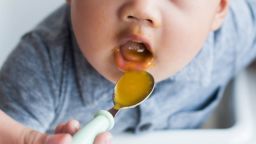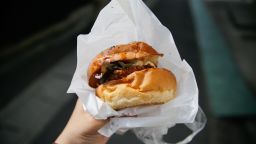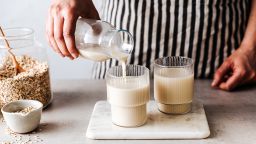The allowable levels of lead in certain baby and toddler foods should be set at 20 parts per billion or less, according to new draft guidance issued Tuesday by the US Food and Drug Administration.
“For babies and young children who eat the foods covered in today’s draft guidance, the FDA estimates that these action levels could result in as much as a 24-27% reduction in exposure to lead from these foods,” said FDA Commissioner Dr. Robert Califf in a statement.
Baby foods covered by the new proposal – which is seeking public comment – include processed baby foods sold in boxes, jars, pouches and tubs for babies and young children younger than 2 years old, the agency said.
While any action on the part of the FDA is welcome, the suggested levels of lead are not low enough to move the needle, said Jane Houlihan, the national director of science and health for Healthy Babies Bright Futures, a coalition of advocates committed to reducing babies’ exposures to neurotoxic chemicals.
“Nearly all baby foods on the market already comply with what they have proposed,” said Houlihan, who authored a 2019 report that found dangerous levels of lead and other heavy metals in 95% of manufactured baby food.
That report triggered a 2021 congressional investigation, which found leading baby food manufacturers knowingly sold products with high levels of toxic metals.
“The FDA hasn’t done enough with these proposed lead limits to protect babies and young children from lead’s harmful effects. There is no known safe level of lead exposure, and children are particularly vulnerable,” Houlihan said.
The director of food policy for Consumers Reports, Brian Ronholm, also expressed concerns. In 2018, Consumer Reports analyzed 50 baby foods and found “concerning” levels of lead and other heavy metals. In fact, “15 of them would pose a risk to a child who ate one serving or less per day,” according to Consumer Reports.
“The FDA should be encouraging industry to work harder to reduce hazardous lead and other heavy metals in baby food given how vulnerable young children are to toxic exposure,” Ronholm said in a statement.
Exposure to toxic heavy metals can be harmful to the developing brain of infants and children. “It’s been linked with problems with learning, cognition, and behavior,” according to the American Academy of Pediatrics.
An FDA official provided the following comment: “Our goal is to reduce the levels of lead in foods to as close to zero as possible. For all foods, with or without action levels, when the agency finds that the level of lead causes the food to be unsafe, we take action.”
Toxic metals in the soil
Lead, arsenic, cadmium and mercury are in the World Health Organization’s top 10 chemicals of concern for infants and children.
As natural elements, they are in the soil in which crops are grown and thus can’t be avoided. Some crop fields and regions, however, contain more toxic levels than others, partly due to the overuse of metal-containing pesticides and ongoing industrial pollution.
The new FDA guidance suggests manufactured baby food custards, fruits, food mixtures — including grain and meat-based blends — puddings, vegetables, yogurts, and single-ingredient meats and vegetables contain no more than 10 parts per billion of lead.
The exception to that limit is for single-ingredient root vegetables, such as carrots and sweet potatoes, which should contain no more than 20 parts per billion, according to the new guidance.
“There are many challenges in lowering the levels of lead that enter the food supply through the environment,” the FDA official said. “Therefore, our priority is to help lower levels of contaminants in foods while also ensuring that families have access to foods, such as root vegetables, that contain nutrients essential for growth and development.”
Dry cereals marketed to babies and toddlers should also not contain more than 20 parts per billion of lead, the new FDA guidance said.
However, the FDA didn’t propose any lead limit for cereal puffs and teething biscuits, Houlihan said, even though the products account for “7 of the 10 highest lead levels we’ve found in over 1,000 baby food tests we have assessed.”
The limit set for root vegetables will be helpful, Houlihan added. Because they grow underground, root vegetables can easily absorb heavy metals. For example, sweet potatoes often exceed the 20 parts per billion limit the FDA has proposed, she said.
More needs to be done
Prior to this announcement, the FDA had only set limits for heavy metals in one baby food — infant rice cereal, Houlihan said. In 2021, the agency set a limit of 100 parts per billion for arsenic, which has been linked to adverse pregnancy outcomes and neurodevelopmental toxicity.
There is much more that can be done, according to Scott Faber, senior vice president of government affairs for the Environmental Working Group, a nonprofit environmental health organization.
“We can change where we farm and how we farm to reduce toxic metals absorbed by plants,” Faber said. “We also urge baby food manufacturers to conduct continuous testing of heavy metals in all their products and make all testing results publicly available.”
Companies can require suppliers and growers to test the soil and the foods they produce, and choose to purchase from those with the lowest levels of heavy metals, Houlihan added.
“Growers can use soil additives, different growing methods and crop varieties known to reduce lead in their products,” she said.
Action items for parents
What can parents do to lessen their child’s exposure to toxic metals? Unfortunately, buying organic or making baby food at home isn’t going to solve the problem, as the produce purchased at the grocery store can also contain high levels of contaminants, experts say.
A 2022 report by Healthy Babies, Bright Futures found lead in 80% of homemade purees or store-bought family foods. Arsenic was found in 72% of family food either purchased or prepared at home.
The best way to lessen your child’s exposure to heavy metals, experts say, is to vary the foods eaten on a daily basis and choose mostly from foods which are likely to have the least contamination. Healthy Babies, Bright Futures created a chart of least to most contaminated foods based on their testing.
Fresh bananas, with heavy metal levels of 1.8 parts per billion, contained fewer heavy metals than other foods tested for the report. After bananas, the least contaminated foods were grits, manufactured baby food meats, butternut squash, lamb, apples, pork, eggs, oranges and watermelon, in that order.
Other foods with lower levels of contamination included green beans, peas, cucumbers and soft or pureed home-cooked meats, the report found.
The most heavily contaminated foods eaten by babies were all rice-based, the report said. Rice cakes, rice puffs, crisped rice cereals and brown rice with no cooking water removed were heavily contaminated with inorganic arsenic, the more toxic form of arsenic.
After rice-based foods, the analysis found the highest levels of heavy metals in raisins, non-rice teething crackers, granola bars with raisins and oat-ring cereals. But those were not the only foods of concern: Dried fruit, grape juice, arrowroot teething crackers and sunflower seed butter all contained high amounts of at least one toxic metal, according to the report.
While buying organic cannot reduce the levels of heavy metals in infant food, it can help avoid other toxins such as herbicides and pesticides, Dr. Leonardo Trasande, director of environmental pediatrics at NYU Langone Health told CNN previously.
“There are other benefits to eating organic food, including a reduction in synthetic pesticides that are known to be as bad for babies, if not even more problematic,” Trasande said.







